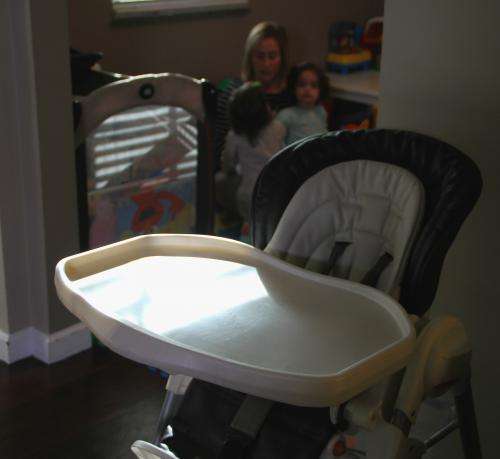High chair-related injuries to children on the rise

High chairs and booster seats are commonly used to help make feeding young children easier. Although most parents assume these products are safe, millions have been recalled in recent years, and injuries associated with their use continue to occur.
A new study by researchers at the Center for Injury Research and Policy of The Research Institute at Nationwide Children's Hospital examined data relating to children age 3 years and younger who were treated in U.S. emergency departments from 2003 through 2010 for high chair-related injuries. On average, more than 9,400 children were treated each year for an injury associated with a high chair or booster seat, equaling one child every hour nationally. In addition, the annual number of injured children increased during the study period.
The study, available online on December 9, 2013 and in an upcoming print issue of Clinical Pediatrics, found that nearly all injuries associated with a high chair or booster seat involved a fall (93 percent). In the cases that reported what the child was doing just before the fall, two-thirds of the children injured were climbing or standing in the chair, suggesting that the chair's safety restraint system either was not being used or was ineffective in these cases.
"Families may not think about the dangers associated with the use of high chairs," said Gary Smith, MD, DrPH, director of the Center for Injury Research and Policy at Nationwide Children's Hospital. "High chairs are typically used in kitchens and dining areas, so when a child falls from the elevated height of the high chair, he is often falling head first onto a hard surface such as tile or wood flooring with considerable force. This can lead to serious injuries."
For High Chair-Related Injuries
Closed head injuries (CHI) – which include concussions and internal head injuries – were the most common diagnosis associated with high chairs (37 percent) followed by bumps/bruises (33 percent) and cuts (19 percent). The number of CHIs increased by almost 90 percent during the study period, going from 2,558 in 2003 to 4,789 in 2010. The body regions most commonly injured were the head/neck (59 percent) and the face (28 percent).
"The number one thing parents can do to prevent injuries related to high chairs is to use the safety restraint system in the chair," said Dr. Smith, also a professor of Pediatrics at The Ohio State University College of Medicine. "The vast majority of injuries from these products are from falls. Buckling your child in every time you use the high chair can help keep them safe."
Dr. Smith also noted that many parents assume the tray will keep a child from jumping or falling out but stressed that the tray was not designed as a restraint, so use of the safety straps is essential.
Other tips for keeping children safe in high chairs include:
Always use the safety straps. Buckling the child in the seat with the straps every time he/she is in the high chair will help set a routine and keep him/her safe by keeping him/her seated and securely in the chair. Make sure the straps are in good working order and firmly attached to the chair. Only use chairs with either a 3-point or 5-point harness that includes a crotch strap or post. Remember – the tray is not enough to keep children in the seat.
Use high chairs appropriately during meal time. Teach your child that his/her high chair is where he/she sits for eating. Allowing him/her to play, climb or stand in the chair can cause it to tip over. Also make sure that older siblings know not to climb on the chair.
Keep the area around the high chair clear. Children are naturally curious and will grab things in their reach. Make sure tablecloths, placemats, sharp silverware, plates and hot food and liquids are out of reach. Also be aware of where you put the high chair. If it is too close to the table, a counter or the wall, the child may knock the chair over by kicking their feet into these objects.
Make sure the chair is stable. Before selecting a high chair for your child, test it out. Chairs with wide bases are often more stable. Using high chairs that meet current safety standards is important. If the chair has wheels, make sure that they are locked into place before use.
Stay with your child during meal time. An unsupervised child is more likely to try to escape from his/her high chair and can also be more likely to choke on his/her food.
Check for recalls. Millions of unsafe high chairs have been recalled during recent years. Make sure the one you are using does not have any known injury hazards. Check http://www.recalls.gov to see if your high chair has been recalled.
The study also compared injuries related to high chairs and booster seats with injuries associated with traditional chairs. More than 40,000 injuries associated with chairs were reported each year during the study period, which equals four children every hour nationally. Falling and jumping from the chair were the leading mechanisms of injury. Children with injuries associated with the use of traditional chairs were more likely to sustain broken bones, cuts and bruises.















